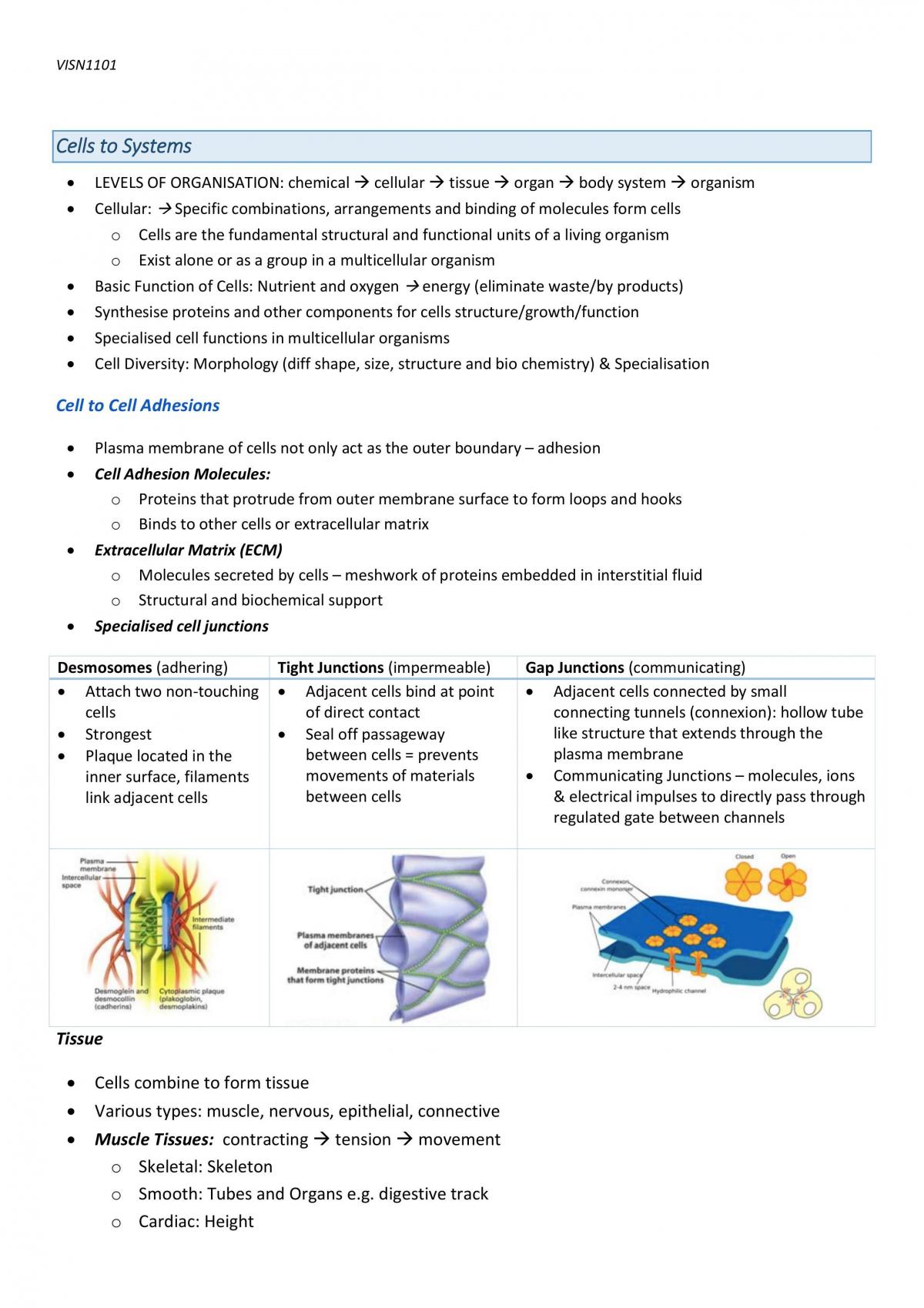Find
Search for over 200,000 study notes and past assignments!
Swap
Download study resources by swapping your own or buying Exchange Credits.
Study
Study from your library anywhere, anytime.
Seeing the World: Perspectives from Vision Science
VISN1101 - Seeing the World: Perspectives from Vision Science
21 Pages • Complete Study Notes • Year: Pre-2021
• LEVELS OF ORGANISATION: chemical cellular tissue organ body system organism • Cellular: Specific combinations, arrangements and binding of molecules form cells o Cells are the fundamental structural and functional units of a living organism o Exist alone or as a group in a multicellular organism • Basic Function of Cells: Nutrient and oxygen energy (eliminate waste/by products) • Synthesise proteins and other components for cells structure/growth/function • Specialised cell functions in multicellular organisms • Cell Diversity: Morphology (diff shape, size, structure and bio chemistry) & Specialisation Cell to Cell Adhesions • Plasma membrane of cells not only act as the outer boundary – adhesion • Cell Adhesion Molecules: o Proteins that protrude from outer membrane surface to form loops and hooks o Binds to other cells or extracellular matrix • Extracellular Matrix (ECM) o Molecules secreted by cells – meshwork of proteins embedded in interstitial fluid o Structural and biochemical support • Specialised cell junctions Desmosomes (adhering) Tight Junctions (impermeable) Gap Junctions (communicating) • Attach two non-touching cells • Strongest • Plaque located in the inner surface, filaments link adjacent cells • Adjacent cells bind at point of direct contact • Seal off passageway between cells = prevents movements of materials between cells • Adjacent cells connected by small connecting tunnels (connexion): hollow tube like structure that extends through the plasma membrane • Communicating Junctions – molecules, ions & electrical impulses to directly pass through regulated gate between channels Tissue • Cells combine to form tissue • Various types: muscle, nervous, epithelial, connective • Muscle Tissues: contracting tension movement o Skeletal: Skeleton o Smooth: Tubes and Organs e.g. digestive track o Cardiac: Height • Nervous Tissues: initiating and transmitting electrical impulses (brain body) o Brain, spinal chord, nerves and special sense organs • Epithelial Tissue: exchanging materials between cell and environment o Epithelial sheets – tightly joined cells, lining covers body o Secretory glands: specialised epithelial tissue (secretion) • Connective Tissues: connecting, supporting and anchoring various body parts o E.g. blood Organs • Two or more types of primary tissue organised to perform a particular function(s) • Groups of organs body systems • Body is made of 11 Homeostasis • Maintenance of a relatively stable internal environment o Establish optimal condition, balanced and steady state • Functions performed by each body system contribute to homeostasis o Detect deviations from normal internal environ. integrate information & make adjustments • Control systems: 1. Intrinsically controlled: built into or inherent in an organ 2. Extrinsically controlled: initiated outside an organ to alter organ activity • Negative Feedback Control: change stimulates a response that seeks to restore to normal by moving the factor in the opposite direction of its initial change • Positive Feed Control: change stimulates a response that seeks to restore normal by enhancing or amplifying the change – same direction of initial change • Feed Forward Control: anticipate and prevent change
This document is 25 Exchange Credits
More about this document:
|
|
This document has been hand checkedEvery document on Thinkswap has been carefully hand checked to make sure it's correctly described and categorised. No more browsing through piles of irrelevant study resources. |
|
|
This is a Complete Set of Study NotesComplete Study Notes typically cover at least half a semester’s content or several topics in greater depth. They are typically greater than 20 pages in length and go into more detail when covering topics. |
|
|
What are Exchange Credits?Exchange Credits represent the worth of each document on Thinkswap. In exchange for uploading documents you will receive Exchange Credits. These credits can then be used to download other documents for free. |
|
|
Satisfaction GuaranteeWe want you to be satisfied with your learning, that’s why all documents on Thinkswap are covered by our Satisfaction Guarantee. If a document is not of an acceptable quality or the document was incorrectly described or categorised, we will provide a full refund of Exchange Credits so that you can get another document. For more information please read Thinkswap's Satisfaction Guarantee. |

Studying with Academic Integrity
Studying from past student work is an amazing way to learn and research, however you must always act with academic integrity.
This document is the prior work of another student. Thinkswap has partnered with Turnitin to ensure students cannot copy directly from our resources. Understand how to responsibly use this work by visiting ‘Using Thinkswap resources correctly’.
Browse UNSW Subjects




